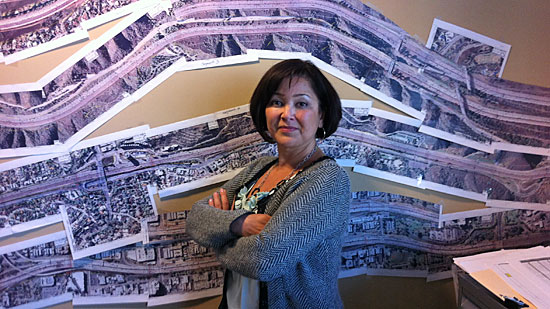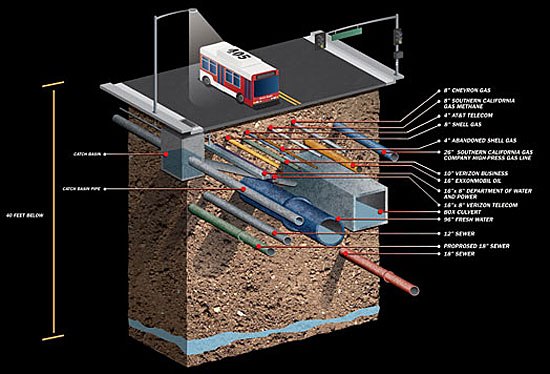Meet the 405 Project’s utility player
December 14, 2011
Bonnie Verdin knows where the wires are buried. Also the sewer pipes, cable conduits and gas lines.
And with the 405 Sepulveda Pass Project heading into its most intensive, multifaceted construction phase yet, she’s under pressure to get it all moved, as quickly and safely as possible.
As Metro’s “third party administration supervisor” on the project, Verdin is a real power player, in every sense of the word. She and her team are charged with making sure that the complex network of utilities running under Sepulveda Boulevard and other construction areas is relocated in ways that satisfy Caltrans regulations, city policies and staffing levels, neighborhood noise standards and the contractor’s need-it-yesterday timetable.
Talk about Mission Impossible.
“The heat is on my back because our contractor needs to get going,” she says as she gets ready to tackle one of the bigger upcoming challenges: moving a 6-inch gas line and an 8” crude oil line in West Los Angeles to clear the way for construction of new “flyover” ramps at Wilshire Boulevard.
Other massive and costly relocation jobs have been averted thanks to design changes as the project has progressed. That means, for example, that a 96-inch water line near the Getty will be staying put, thanks to a redesign that moved the construction far enough to the west to avoid the line.
Upcoming work on the Wilshire ramps and around the Getty are key as the project seeks to make up for lost time, some of it due to the scrapping of a plan that would have built a new Mulholland Bridge over the freeway before tearing down the old one. The reversal of that plan led to last summer’s “Carmageddon,” which Verdin watched from the comfort of her Whittier home.
While the rest of Southern California regarded the Mulholland Bridge demolition with trepidation because of the planned lengthy shutdown of the freeway, Verdin had another preoccupation: an 8-inch high-pressure gas line running through the bridge. With onsite crews monitoring the gas line, it came through the demolition unscathed. (The process will be repeated next year when the other side of the bridge is torn down.)
It’s not all about what lies beneath. Sometimes the job requires taking overhead power lines underground—an aesthetic bonus in the long run but potentially disruptive to the neighborhoods involved while the utility relocation work is going on.
Then there’s the responsibility of running interference among the 20-plus utility owners and agencies involved—from AT&T to Verizon, with everyone from Chevron to the Los Angeles Department of Water and Power in between.
“You can see the complexity and congestion,” she says with a bit of understatement. (For a look at just how complex, check out this Metro graphic of subterranean Sepulveda Boulevard.)
Even when everybody’s on board, she still has to help broker who gets first dibs on working on a given stretch of the project at a given time—something that’s cropped up when project contractor Kiewit Pacific Co. and the city Department of Water and Power both have crews ready to go with different missions to accomplish.
Verdin, 55, who previously was in charge of utility relocation for the Orange Line, has been with Metro for 21 years. In 2008, she started work on the 405 project, which will add a 10-mile northbound carpool lane along with an array of other improvements. The project is set to finish in 2013.
Her first move, as any household contractor knows, was to get it touch with DigAlert for a full picture of the subterranean utility landscape.
Then it was time to determine who was responsible for every piece of it. Establishing what’s known as “right of occupancy” was essential to figuring out who would foot the bill for moving each line and pipe. (Because it’s a joint Metro-Caltrans operation, the complex rules governing the relocation effort mean that some of the costs are paid from the project budget and others are borne by the entities that own the lines. Some $44 million is currently budgeted for utility relocation in the project budget, with millions more coming from individual utility owners.)
Verdin’s academic background is in food and nutrition sciences, but her work in utility relocation has provided a steady diet of diplomatic challenges.
“I would say that my job is to broker consensus, really, among the parties,” she says. “It teaches one patience and persistence.”
Posted 12/14/11














 405 bridge work causes a stink
405 bridge work causes a stink
